
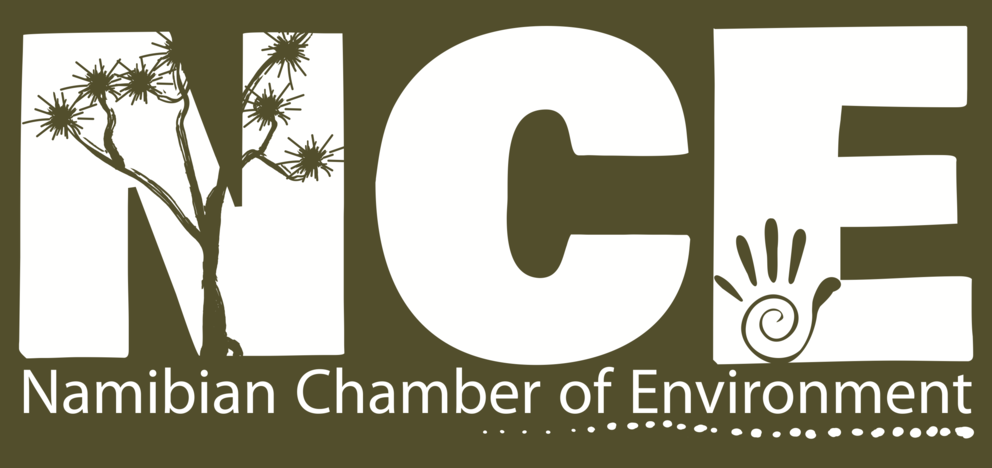
The Great Elephant Balancing Act
Namibian Chamber of Environment
21st September 2020
This article benefited from the input of four elephant conservation experts.
Elephants are amazing animals. Besides being the largest land animal on our planet, they have relatively complex societies and appear to have individual personalities. Watching elephants in their natural habitat is a joy for those of us who can do so at our leisure, from a safe distance or with a knowledgeable guide. For those who face the real danger of meeting an elephant on foot at night while walking home, elephants can be terrifying.
It is no wonder that the idea of hunting elephants is a sensitive one, and that the people who spend much of their time observing these ponderous, loveable beasts want to do everything in their power to protect them. There is also little wonder that people living with elephants want them to be more controlled – to stay away from their crop fields and houses. Yet, as with many things, how you see an elephant is a matter of perspective and managing this species must take vastly different perspectives into account, along with the relevant science.
The topic of elephant management requires a book (or several), and I am not an elephant expert, so I will leave that task to others. My primary interest lies in the field of human-wildlife conflict, which affects humans in every part of the world and a dizzying array of species, including elephants. So these observations are not limited to elephants, although popular opinions about elephants and the intense conflict among different interest groups over whether or not they should be hunted make this species a great case study.
There are two sides to human-elephant conflict, and both sides have been studied in Botswana and elsewhere. We will dive into some of the science of these two sides first, before considering how these two sides should inform the tricky business of elephant management.
The Elephant Dimension

Elephant hunting is the most controversial aspect of elephant management, particularly when it is for ‘sport’ or ‘trophies’, whereby hunting clients pay large amounts of money to hunt large male elephants. Elephants may also be hunted due to human-elephant conflict – whereby a particular individual is earmarked because it causes repeated damages to crops or infrastructure, or for killing people. Hunting an older male elephant for ‘sport’ is more controversial than hunting in response to conflict. Scientific studies of male elephants thus elicit popular attention and are frequently used in hunting debates.
A recent study by Allen et al. entitled Importance of old bulls: leaders and followers in collective movements of all‑male groups in African savannah elephants discovered that mature elephant bulls play a role in leading younger bulls, particularly when travelling to the Boteti River in central Botswana. They found that adolescent males (< 20 years old) rarely travelled to the river alone, but preferred accompanying mature bulls. Additionally, in groups of males, the older ones were most likely to take the lead. The oldest age category they used was over 26 years, which is really just the age of maturity, rather than an indication of particularly old individuals (elephants can live up to 60-65 years).
The authors conclude that older male elephants are therefore important for determining movement patterns for younger males in the landscape (they go further than that, to be discussed later). Other elephant biologists have noted that older males function as disciplinarians
for younger ones – teaching them appropriate behaviour within elephant society and even towards other species. The latter observation is supported by the experience in Pilanesberg National Park, South Africa, where male elephants that were orphaned due to historical culling operations were released into the Park without older elephants. These traumatised young males caused havoc by killing rhinos and attacking tourist vehicles. The introduction of older males into this population caused the troublemakers to calm down.
Another line of scientific evidence that emphasises the importance of male elephants is from a paternity study in Amboseli National Park, Kenya. This study revealed that male elephants reach their breeding peak (i.e. number of calves they father) between 45-53 years old and they can still reproduce in their late 50’s, although their numbers of offspring decline sharply in these later years. The conclusion one can draw from these results is that male elephants should ideally not be hunted before or during their prime reproductive age of around 40-50 years old. Elephants older than this have already contributed a great deal to the population; their genes will therefore not be lost if they are hunted when they are past their prime (more about age-related hunting can be found here).
Allen et al. also point out that male elephant society differs from female society in a number of important ways. First, males will group together or split with others over time, while female breeding herds stay together and do not randomly split up and regroup. Second, the matriarch walks at the back of her herd to keep a watchful eye on those in front of her, thus actively caring for her group. Meanwhile old males walk at the front and seem unconcerned about whether or not they are being followed by younger males. Finally, adolescent females do not travel large distances anywhere on their own (unless something is seriously wrong), while adolescent males do, even though they prefer the company of older males.
In terms of their function in elephant society, then, it is reasonable to say that older females (matriarchs or soon-to-be matriarchs) are more important than older males, although it is certainly not advisable to remove all older males from the population. The scientific evidence showing that older male elephants have a role to play is important, and should certainly be incorporated in elephant management plans – no subpopulation of elephants should be left without mature elephant bulls.
Yet Allen et al. do not stick to their scientific findings in the concluding remarks of their paper, as they state: We argue mature bulls occupy a similar role in male elephant society as old female matriarchs in breeding herds and require equal protection
(emphasis mine). They further argue that the quota of 400 male elephants set by Botswana for 2020 would not be sustainable
. With that, they stepped out of elephant biology and into the human realm of policy.
The Human Dimension
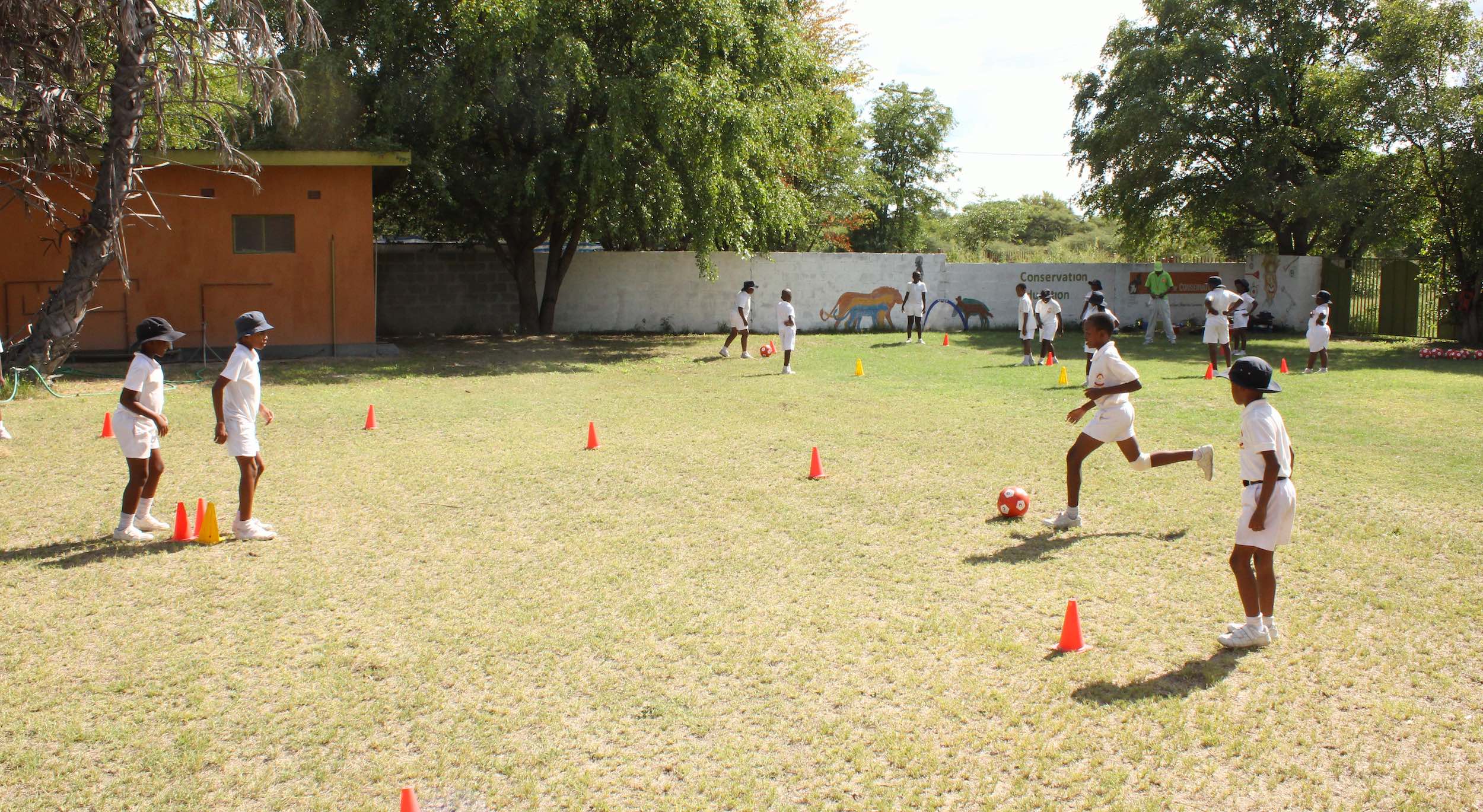
While the practice of science – creating and testing hypotheses, gathering and analysing data, drawing conclusions and suggesting real-world applications, and finally submitting it all for peer review – is designed to reduce our inherent bias as much as possible, the fact remains that scientists are humans too. People who study animals, particularly animal behaviour (which requires many hours of watching them) naturally become attached to their study species. Indeed, they probably had a natural affinity for those species before they even started their studies, which was why they became biologists in the first place.
I can empathise with this – the reason why I chose to study carnivore conservation biology is because I have always loved cats of every kind. Yet I have an issue with the conclusions reached in this paper. First, the conclusion that male elephants should have equal protection to matriarchs is an over-reach, as even in the paper itself they describe how older males are less important to younger males than matriarchs are to younger females.
Second, the elephants they are concerned about (>26 years old) represent 19% of the males in their sample of 1,097. If one considers that there are 130,000 elephants in Botswana, let’s say half of which are male (65,000), then we have roughly 12,000 mature males in the country (this is a rough estimate, based only on their reported demographics and assuming a 50:50 sex ratio – quota setting is a much more complicated business in reality). A quota of 400 adult male elephants thus equates to about 3% of the available males (note that 400 is a maximum, actual numbers hunted are likely to be lower). If only 3% of the older males are removed from the population, will male elephant society break down such that younger males start behaving badly like those in Pilanesberg where no older males were present? Or will young males have no older males to follow to the river, as they did in this study? The numbers just don’t add up, revealing that their conclusions stem from an understandable desire to protect the elephants that they have spent so much time studying, rather than the results of their study.
While the results of good biological research such as those summarised above must be incorporated into animal management, the views of animal researchers must be considered alongside the views of other stakeholders. The conclusions regarding elephant hunting (but not the results or other conclusions based on their data) of Allen et al. are clearly personal views, and should be considered as such. Furthermore, biological science is not the only scientific discipline that should inform animal management policies. After reading the article by Allen et al. on male elephants near the Boteti River, I looked for an article on people living near the same river to get the other side of the story. Interestingly, both studies included one author (a different person in each one) from the non-governmental organisation Elephants for Africa, which is working to reduce human-elephant conflict in this area and clearly understands both the elephant and human dimensions of this situation.
The study by Mayberry et al. is entitled Well-being impacts of human-elephant conflict in Khumaga, Botswana: Exploring visible and hidden dimensions. Khumaga is a village located on the Boteti River, which is associated with several smaller farming settlements that stretch either side of the village along the riverfront. The Boteti River is also the boundary between farming areas and the Makgadikgadi Pans National Park, which supports over 2,000 elephants (most of them male, for as yet unknown reasons). At the time of this study, the boundary fence of the Park was in severe disrepair so the elephants regularly crossed the river into the farming areas and back into the Park.
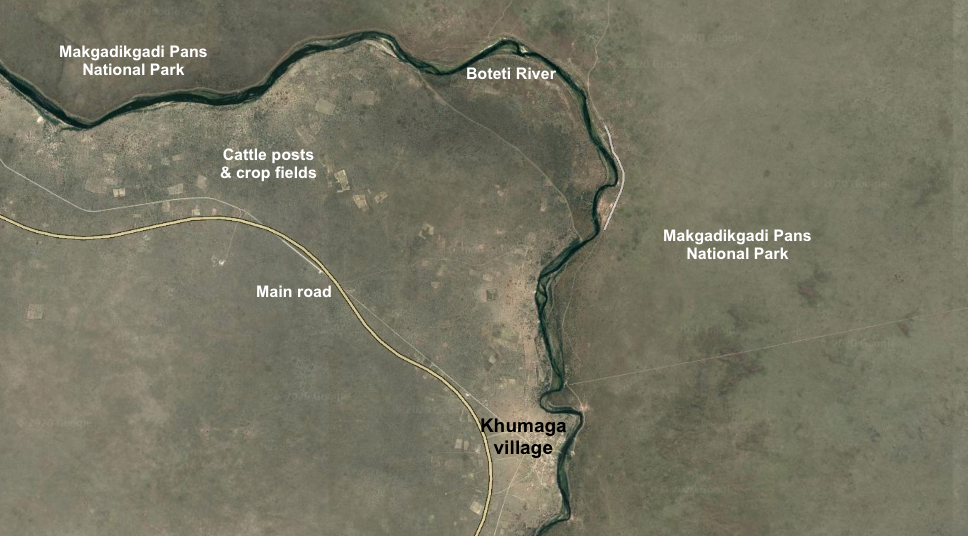
The researchers wanted to know how the presence of elephants impacted the people living along the Boteti River. They went deeper than the usual tallying up of elephant damages (e.g. destroying crops or breaking fences) and also asked their 61 respondents about the impact of elephants on their personal security and freedom, physical and mental health, and relations with their families and the government.
They found that 72% of their respondents felt unsafe around elephants and that the presence of the elephants limited their freedom of movement, especially at night. Even more worryingly, 90% reported that the damages caused by elephants to crops threatened their food security. Food is expensive in Botswana relative to the earning power of rural people, so not having a good yield from their crops means that these subsistence farmers may not have enough to eat, as their sources of cash income are limited. Nearly two-thirds (63%) of interviewees said that their access to water was hampered by the presence of elephants at the Boteti River. While limiting their access to food and water was a clear physical health concern, a quarter of the interviewees also reported an intense fear of elephants – thus affecting their mental health.
Balancing the dimensions – the tricky issue of management
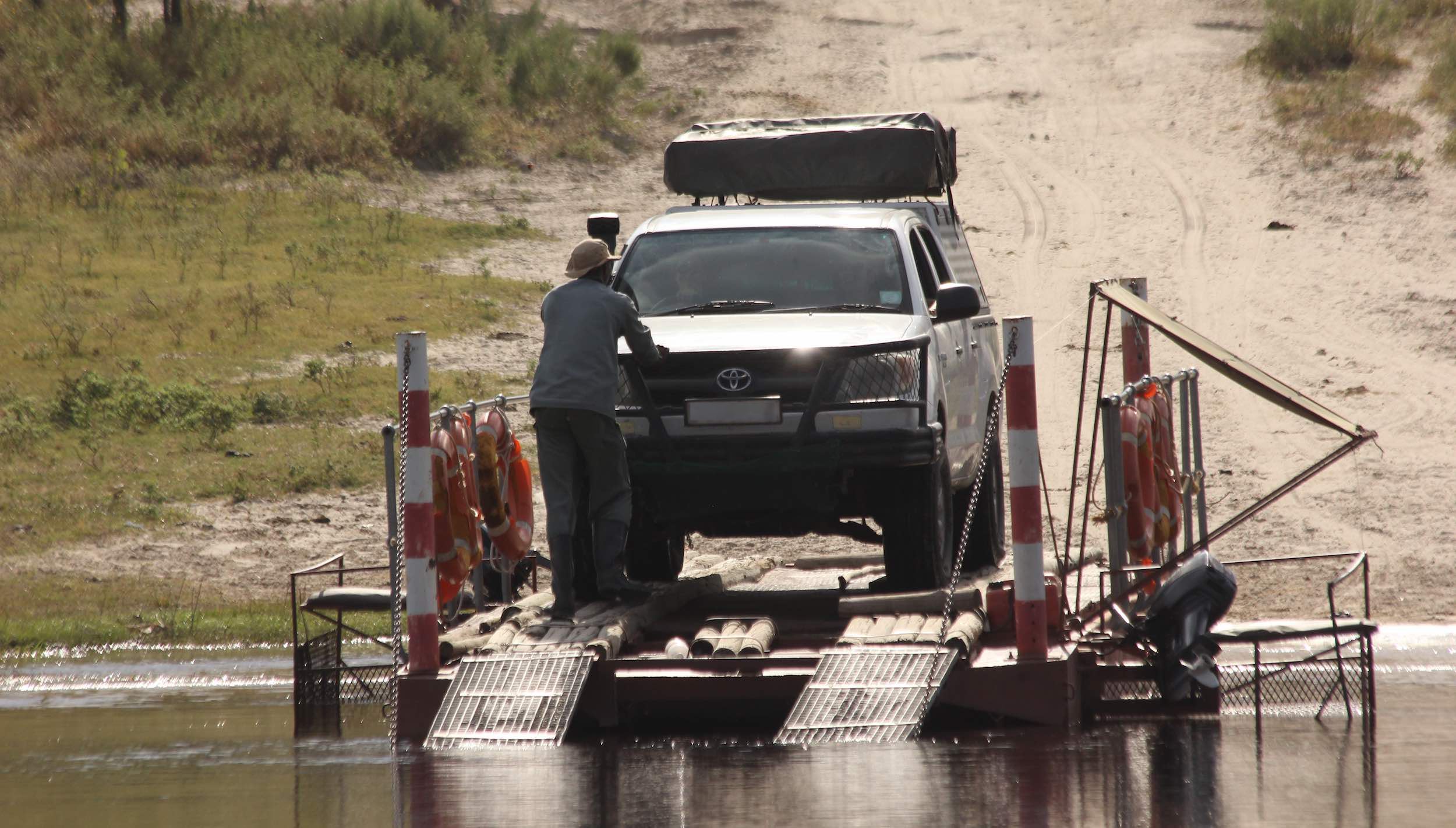
Unsurprisingly, the people living near the Boteti are frustrated; their main request was that the Park fence be reinforced. Given that the river is the boundary and people also need access to the river, they want the fence to be reinforced on the Park’s side of the Boteti River. Yet, as the elephant study showed, this river is a critical resource for elephants, so any fence blocking their access to the river is likely to be broken down by elephants desperate to quench their thirst. The government suggested moving the boundary of the Park such that the Boteti is within the Park and human communities are fenced out and therefore safe from elephants. Yet the river is a key source of water for these farming communities, so they were unwilling to give up their land and this critical resource to the Park.
Considering this local situation gives us an idea of the complexity involved in managing elephants, and all other animal species that conflict with humans. While the area around the Boteti is a hotspot for human-elephant conflict, it is certainly not the only one in the country. If trying to please its citizens while simultaneously conserving its large elephant population was the only struggle the Botswana government had to deal with, that would be difficult enough. Recent media furores over their decision to allow elephant hunting and some mysterious (now known to be natural) elephant deaths, however, reveal that Botswana is being watched and judged internationally. Namibia has experienced its share of international judgement over its wildlife management policies, so we can commiserate with our neighbour.
Both countries allow elephants to be hunted (along with several other African countries), much to the dismay of people who love elephants, yet don’t have to compete with them for food and water. Hunting permits are invariably granted for male elephants, particularly older ones that bear larger tusks. The quota in Botswana is set at 400 adult male elephants. Yet scientists say that older male elephants are critically important, so we cannot allow this!
Cry the activists from afar. Very rarely does anyone stop to critically assess the differences between what scientists actually found and what they recommend, as I did above.
Studies like the one by Allen et al. are used as a club by international media to batter Botswana and other elephant hunting countries into submission. This article was popularised by no less than the New York Times and the BBC, among many others. Yet the findings of Mayberry et al. – that 90% of people living alongside the Boteti River are food insecure as a result of elephants, not to mention the other impacts – remain tucked away in a scientific journal article, to be read only by scientists interested in the topic of human-elephant conflict. The next time someone says that elephants should be managed based on science, ask them what science – just the science focusing on the elephant dimension, or all of the science?
What are we trying to achieve?
Besides using science to guide management, one also needs to ask a critical (but often overlooked) question – what is the ultimate objective for management in this particular area? The answer to this question then guides how the science should be used. The objectives for National Parks are usually to conserve plant and animal species, although they may also include generating income for Park management and the country. Yet on the edges of Parks and outside them, either in buffer zones or on farmlands, the objective may be different. Particularly in areas where people are present, the objectives have to include their needs – ignoring them is both a violation of their rights and a recipe for disaster.
Around the world, in nearly every human-wildlife conflict situation, whenever people feel that the authorities tasked with managing wildlife are ignoring them or trampling their rights, conflict intensifies. Anger and frustration generated by such intense conflict can reveal itself in a multitude of ways, including public protests, increased poaching, and a distrust of conservation officials generally. More often than not, the animals are used as a pawn in a greater conflict between different groups of people, with sometimes devastating results.
I hope we can all agree that no one wants human-wildlife conflict to escalate to the point of no return. If so, some compromises between the different human interest groups must be made. Within strictly protected National Parks, elephants and other animals should be allowed to continue their lives as unimpeded by human activities as possible (tourism can, and does, cause some issues but this should be minimised by managing the humans, rather than the animals). Outside the Parks, we need to be more flexible.
The existence of wildlife in human farmlands relies directly on the level of tolerance farmers have for it. Our efforts should therefore focus on maximising tolerance, which is achieved primarily through listening carefully to the concerns raised by the people in question and genuinely making an effort to address these. As a rule of thumb, we should aim to reduce the costs people experience and increase the benefits they derive from the presence of wildlife.
Achieving either or both of these goals may require the sacrifice of a few individual animals – e.g. killing or translocating particular individuals that habitually cause conflict (reducing the cost), or allowing a few older males to be hunted by foreigners and thereby generate income and meat for the affected community (increasing the benefit). There is much scope for further research into the long-term impacts of removing individual elephants (either as ‘problem-causing’ or for income generation) on the level of human-elephant conflict, and we hope to pose some of these pertinent research questions in a future article.
This is not to say that non-lethal efforts should not be attempted – they are needed just as much. Around the Boteti, education regarding how to behave when seeing elephants will reduce fear, better fencing around crops will reduce damages, and providing piped water near settlements can reduce direct competition for water. Elephants for Africa is heavily involved in helping this community live with elephants using an array of non-lethal methods – this article in no way criticises their efforts. In terms of income generation, finding different sources of revenue to incentivise tolerance for elephants and other wildlife that do not rely on foreign visitors (with cameras or guns) would increase the resilience of African conservation and is therefore a welcome endeavour.
The various different actions one can take to reduce human-wildlife conflict are often likened to a ‘toolbox’, with each tool being needed for a different task and under different circumstances. Precluding the use of lethal methods reduces the size of the toolbox and may even render our non-lethal tools less effective. If people ask for a particular elephant to be removed, yet conservation authorities respond with an educational talk on the importance of elephants without explicitly addressing their request or trying to understand their point of view, the effort may be seen as patronising – at best! In practice, government conservation authorities need to implement policies regarding elephant management (either in terms of identifying and removing individual ‘problem animals’ and/or granting quotas for hunting elephants) that include the needs and perspectives of their citizens who live alongside elephants.
Striking the balance
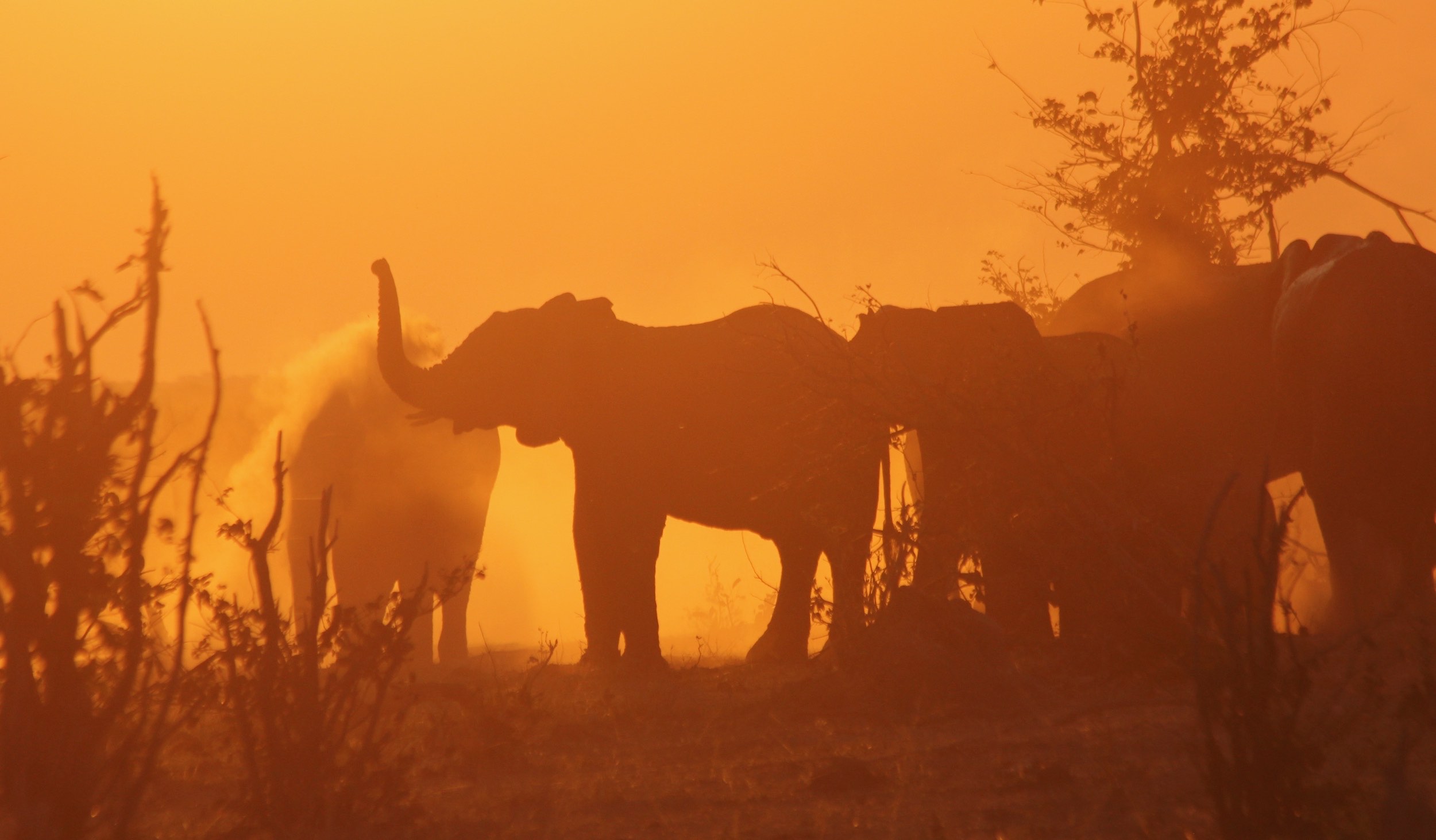
Elephant behaviour and society are complicated things that will no doubt continue to attract the attention and fascination of many scientists. Yet understanding and mitigating human-elephant conflict is more complicated still. Countries that must find the delicate balance between the rights of their citizens and their responsibility for conserving biodiversity should be supported, particularly by providing sound scientific evidence on both the elephant and human dimensions of the problem.
Scientific findings should not be used as a club to beat countries into making policy changes, and scientists must realise that their perspectives on elephants are not the only ones that matter. Constructive engagement between policymakers, affected communities and scientists cannot happen if we ignore each other’s perspectives and real concerns. While the international media is partly to blame for making a difficult situation worse, each party can choose to either stoke the fires of conflict or douse the flames by trying to understand the other side’s point of view. Perhaps the proverbial question should not be how do you eat an elephant?
but how do you see an elephant?
For articles on similar topics, please click one of the following options:
If you enjoyed this page, then you might also like:
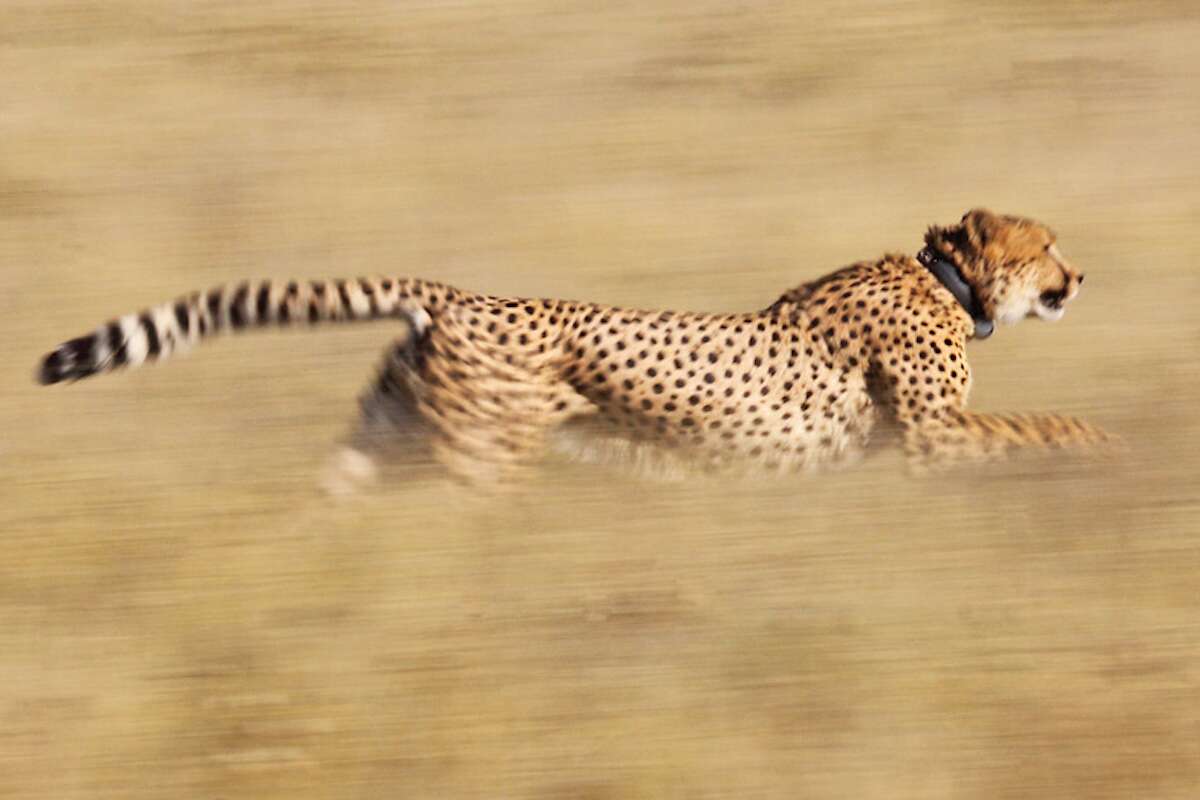
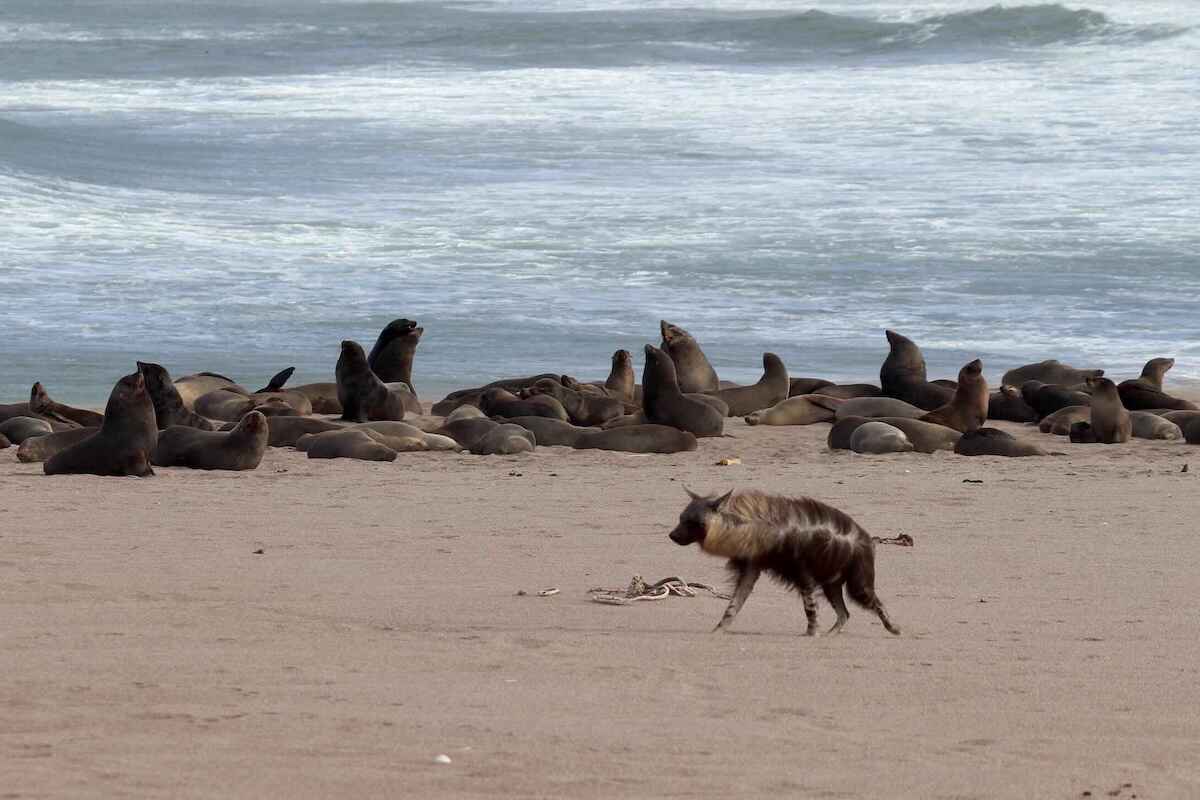

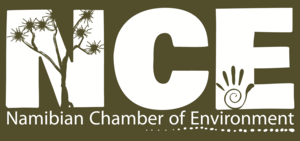
The Namibian Chamber of Environment (NCE) is an umbrella Association that provides a forum and mouthpiece for the broader environment sector, that can lobby with government and other parties, that can raise funds for its members and that can represent the sector.
www.n-c-e.orgThe Namibian Chamber of Environment (NCE) is an umbrella Association that provides a forum and mouthpiece for the broader environment sector, that can lobby with government and other parties, that can raise funds for its members and that can represent the sector.
www.n-c-e.org
Gail C. Thomson is a carnivore conservationist who has worked in South Africa, Namibia and Botswana on human-carnivore conflict, community conservation and wildlife monitoring. She is interested in promoting clear public communication of science and conservation efforts in southern Africa.
Gail C. Thomson is a carnivore conservationist who has worked in South Africa, Namibia and Botswana on human-carnivore conflict, community conservation and wildlife monitoring. She is interested in promoting clear public communication of science and conservation efforts in southern Africa.
We use cookies to monitor site usage and to help improve it. See our Privacy Policy for details. By continuing to use the site, you acknowledge acceptance of our policy.